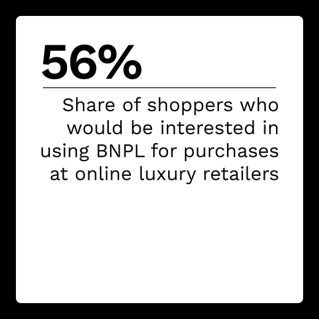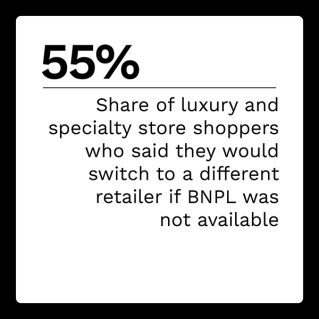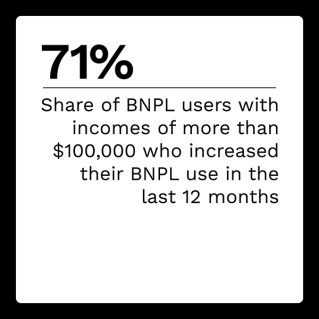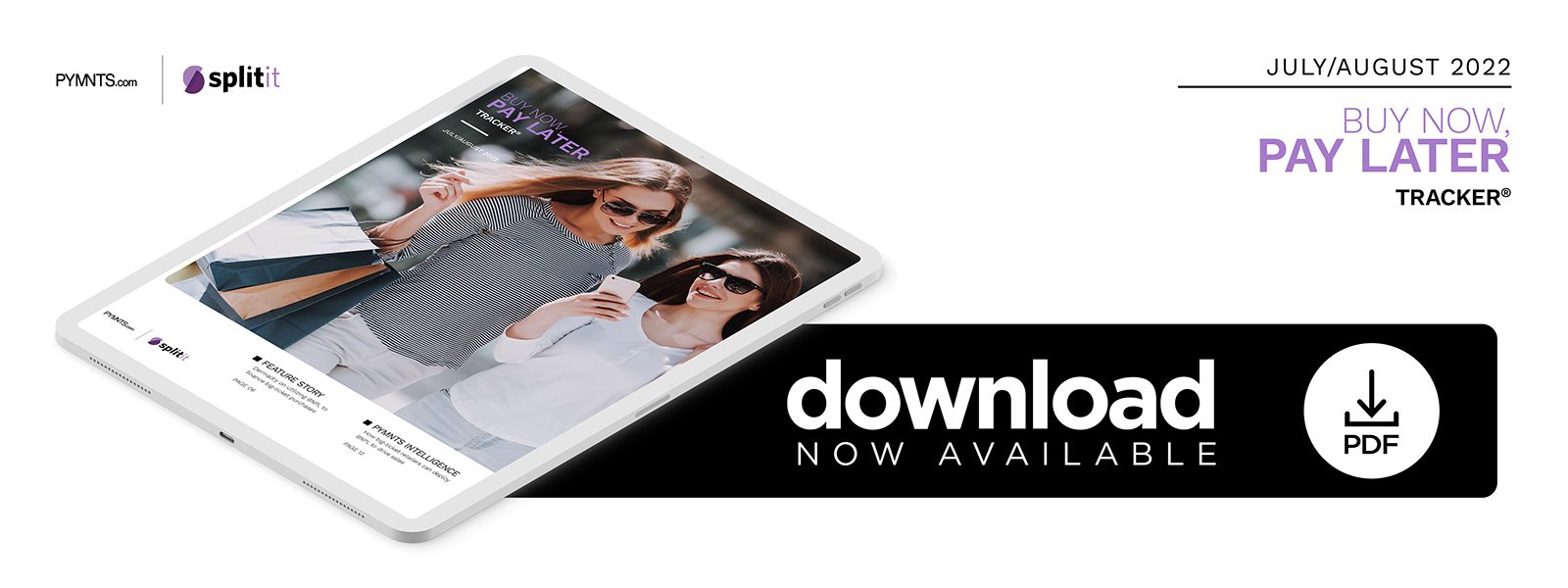71% of Affluent BNPL Users Increased Their Use in Last 12 Months

Buy now, pay later (BNPL) services have become a way of life among younger generations and lower-income consumers in the past few years, with their use quickly growing over time. Certain industries see greater usage than others, with 44% of BNPL users saying they used BNPL to purchase clothing or accessories and 42% leveraging these options to buy electronics and appliances.
The use case for more affluent consumers is growing, with an expanding consumer base deploying BNPL to make one-time, big-ticket purchases such as luxury goods or expensive electronics. This use is especially prevalent online, generally delimited by its availability: 52% of luxury retailers offer BNPL online compared to just 28% offering it in-store. The spread of BNPL to high-end industries is also bringing in wealthier, older demographics that would not have previously considered this option. More than 46% of baby boomers and seniors increased their use of BNPL in the last year, and 71% of BNPL users whose incomes exceed $100,000 and who used BNPL options in the last 12 months increased their use in the same time period.
This edition of the “Buy Now, Pay Later Tracker®” examines the growing role of BNPL in big-ticket and luxury spending, how these markets are serving as a bridge to older, more affluent buyers who have not previously been BNPL enthusiasts and what that means for merchants and consumers alike.
Around the Buy Now, Pay Later Space
 BNPL has become a household name in recent years, with significant portions of the population either actively using it on a daily basis or at least considering climbing on the bandwagon. A recent survey found that 30% of consumers were considering using BNPL this month, including 21% who said they might apply and 9% who said they definitely would. Another 31% said they expected to apply for a BNPL loan at least once within the next six months, and 8% planned to do so at least three times. As more consumers discover the method and become regular users, interest in BNPL is unlikely to wane.
BNPL has become a household name in recent years, with significant portions of the population either actively using it on a daily basis or at least considering climbing on the bandwagon. A recent survey found that 30% of consumers were considering using BNPL this month, including 21% who said they might apply and 9% who said they definitely would. Another 31% said they expected to apply for a BNPL loan at least once within the next six months, and 8% planned to do so at least three times. As more consumers discover the method and become regular users, interest in BNPL is unlikely to wane.
BNPL’s popularity has attracted the scrutiny of world governments, and many are implementing legislation and regulation to protect consumers. Australia is the latest country to join this club, with Financial Services Minister Stephen Jones announcing that BNPL will soon be subject to the same laws that regulate credit card providers. The BNPL industry has been independent until now, as its product technically is not credit in the traditional sense. Jones told reporters that the difference was largely academic and that he would work with Treasurer Jim Chalmers to lay out what the new regulations would mean for the BNPL industry in Australia.
For more on these and other stories, visit the Tracker’s News and Trends section.
Dermadry on Deploying BNPL to Finance Big-Ticket Purchases
Consumers who can afford luxuries are increasingly turning to BNPL to buy big-ticket items. Not only does this mean these consumers may have the opportunity to spend more than they otherwise would, but it also offers the benefits of improved market reach. Dermadry promotes BNPL to reach more consumers and offer them opportunities to purchase items they otherwise could not.
To learn more about how BNPL can help both merchants’ bottom lines and consumers’ buying power, read the Tracker’s Feature Story.
How Big-Ticket Retailers Can Deploy BNPL to Drive Sales
 BNPL services have quickly gained a large foothold in the retail scene, becoming a household name in digital payments within a short period of time. A recent study found that 25% of eCommerce shoppers in the U.K. now use BNPL, with 20,000 different merchants offering it at the point of sale. These services have traditionally been the domain of younger, lower-income demographics, but these options are expanding to older, wealthier demographics.
BNPL services have quickly gained a large foothold in the retail scene, becoming a household name in digital payments within a short period of time. A recent study found that 25% of eCommerce shoppers in the U.K. now use BNPL, with 20,000 different merchants offering it at the point of sale. These services have traditionally been the domain of younger, lower-income demographics, but these options are expanding to older, wealthier demographics.
Merchants that sell these big-ticket items are becoming aware of this new customer base and are rolling out BNPL options to take advantage of the larger ticket sizes and improved conversion opportunities they afford. An availability gap remains, however, with demand outpacing supply for BNPL services among these customers.
To learn more about how big-ticket retailers can deploy BNPL to drive sales, read the Tracker’s PYMNTS Intelligence.
About the Tracker
The “Buy Now, Pay Later Tracker®,” a PYMNTS and Splitit collaboration, examines the growing role of BNPL in big-ticket and luxury spending and how these markets are serving as a bridge to older, more affluent generations and demographics.

